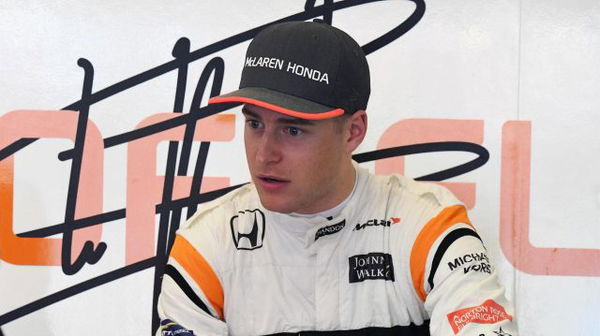

Recall Bahrain last year, an injured Fernando Alonso being ruled out of the race, in steps McLaren’s highly rated protege Stoffel Vandoorne who flew in the last minute to substitute for the Spaniard

ADVERTISEMENT
Article continues below this ad
Wind-up the clock to the present and the same Stoffel Vandoorne is struggling, actually struggling would be an understatement, he his getting whitewashed by his team-mate. Given Fernando Alonso is a benchmark and easily ranks amongst the sport’s greatest drivers but still, that does not explain why Vandoorne has been languishing soo far behind him.
Vandoorne is meant to be McLaren’s answer to Max Verstappen, one of an elite breed of junior single-seater stars of recent seasons – alongside Mercedes proteges Pascal Wehrlein and Esteban Ocon, and Ferrari hopefuls Antonio Giovinazzi and Charles Leclerc – considered to have the potential to dazzle in F1 if given sufficient opportunity.

Vandoorne has won races at every level in which he’s raced – including Japanese Super Formula. Great things are expected of McLaren’s prodigy, but so far his first full season in F1 hasn’t gone to plan.
Vandoorne failed to escape Q1 in any of the first five races, while team-mate Alonso made Q2 at the first four and qualified inside the top seven for his home grand prix in Spain.
The average gap between them in qualifying is 0.601s. That puts him in the bottom three of 2017 performers when measured against their team-mates – ahead of only Williams rookie Lance Stroll who is 0.922 down against Felipe Massa and Jolyon Palmer who is 1.250 down on Renault team-mate Nico Hulkenberg.
The races have been largely disappointing as well – last of the classified finishers in Australia; only just ahead of the Saubers in Russia; a silly incident with Massa in Spain for which Vandoorne received a grid penalty and another crash in Monaco, add another dismal performance in Canada.

While it’s true Vandoorne has been a victim of McLaren-Honda’s torrid reliability record since pre-season testing at Barcelona – causing him to retire in China and fail to even start the race in Bahrain – and that Honda’s continuing difficulties extracting decent performance from the engine have made his life harder still, that doesn’t fully explain why Alonso has demolished Vandoorne so far.
Things have been going so badly that Vandoorne was summoned to McLaren HQ in Woking ahead of the recent Monaco GP for crunch talks on how to reverse his disappointing run of form.
McLaren says Vandoorne has been struggling to adapt to the greater technological demands of F1 compared with the single-make junior formulas he grew up in. Over the first five races Vandoorne wasn’t able to find a set-up direction with the MCL32 that suited his driving style, and as a consequence, he was way off Alonso’s pace.
Eric Boullier recently gave an insight into the team’s young driver’s woes: “When you come from these kinds of junior categories, it’s the same car for everybody, so you have a driving style you have developed around this car to drive them, Formula 1 is different – every

Vandoorne has also had to cope with the formidable presence of Alonso on the other side of the McLaren garage. That’s not easy for any driver, but arguably it’s even harder for a rookie who idolised Alonso growing up, watching him win world championships for Renault and dethrone the legend that is Michael Schumacher in the process.

Confidence and assertiveness are very important in Formula 1, and it’s common to see rookie drivers get browbeaten by team personnel with more experience, struggling to make their own voices heard and communicate exactly what they need from a car in order to go fast.
Equally, experienced engineers often underestimate the fallibility of human drivers, over-engineering the cars to a point where it can be impossible for some drivers to extract performance from them.
They will argue the driver should simply adapt – and the very best ones usually can – but you can often find that sacrificing 1% of performance from the car in a certain area to which a driver is particularly sensitive might allow that driver to extract 3% more from their car overall, which constitutes a net gain.

Boullier even protects his driver not only outside the team but also within, he tells how engineers hark back to the days of Hamilton and say that Lewis stepped in and straightaway started to win, to whom he replies that Hamilton did 30,000 miles of testing!
Jumping now from a Formula Renault to F2 is exactly same, except you have more grip and more power. But from F2 to Formula 1 there is the differential, the aero, the brakes, braking by wire, engine braking – it’s completely different.
Vandoorne arrived in Monaco in a much better frame of mind, admitting he had not felt “100% confident with the car” over the first five races and had taken some time to “get to grips” with the people around him.
He felt sure Monaco would turn out to be a much stronger weekend and so it proved, despite the ultimate result. He built up speed carefully on his first visit to Monte Carlo in an F1 car and was impressively fast in qualifying, making Q3 for the first time.
OK, there were two unfortunate crashes. He shunted at the end of Q2 when he clipped the inside barrier at the second part of the Swimming Pool complex – something that Verstappen

But the important thing is the pure performance was there. That’s what McLaren hoped to see at last from a driver it has invested so much in already, and wants to keep investing in for the future. In Monaco, Vandoorne was “back to the Stoffel I know”, according to Boullier.
On F1’s trickiest track, Vandoorne showed some genuine signs of life after a deeply disappointing run of underperformance. Now he must produce consistently – the speed must remain, he must add results, and he must cut out the incidents.
And he must maintain his mojo alongside Alonso who is on the other side of the McLaren garage. That is a very different challenge to taking on Jenson Button, who – world champion though he is – hadn’t driven an F1 car since November yet wasn’t far off Vandoorne’s pace during a one-off drive in Monaco.
Canada was once again a disappointing result as the returning Alonso once again trounced

ADVERTISEMENT
Article continues below this ad
But Vandoorne nevertheless for once at least so far in the season looked more like the driver F1 expects him to be. Now we wait to see whether the same Vandoorne – the superstar McLaren is convinced he is – turns up in the upcoming races, or whether Alonso will continue making him look distinctly second-rate.
ADVERTISEMENT
Article continues below this ad

ADVERTISEMENT
ADVERTISEMENT
ADVERTISEMENT
ADVERTISEMENT

